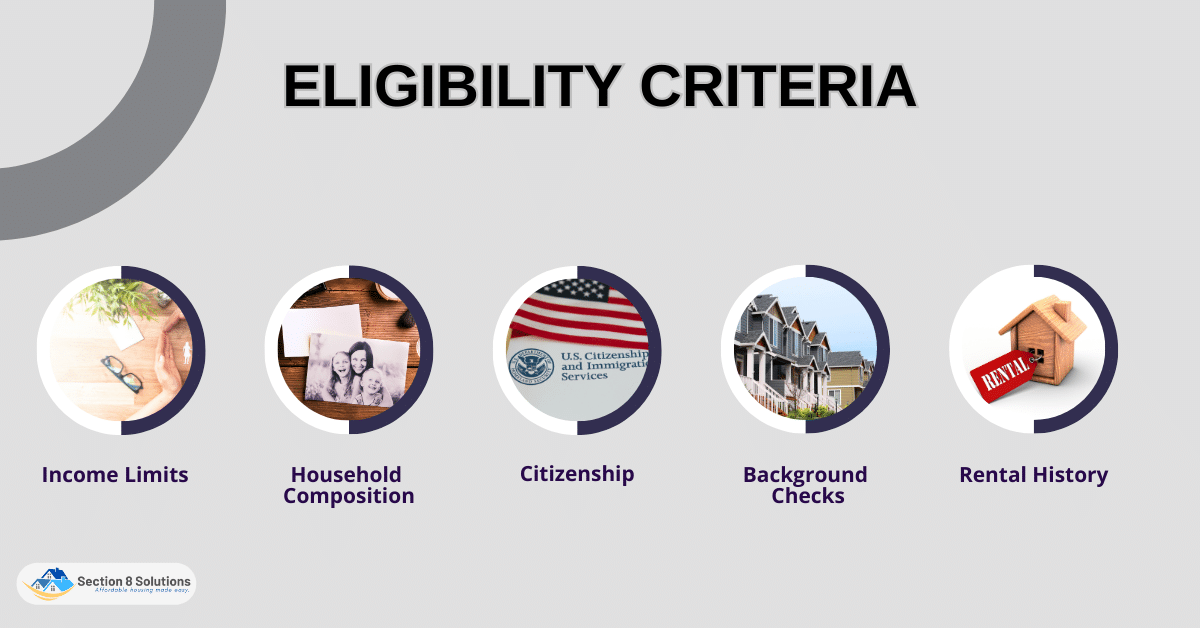These federal initiatives, managed by Oregon Housing and Community Services (OHCS) in partnership with local housing authorities, offer vital assistance to low-income individuals and families. With a mission to provide safe and decent homes, Section 8 Housing Programs serve as a beacon of hope, fostering stability and empowering communities across the state.
This blog aims to shed light on the purpose and significance of the Section 8 Housing Programs in Oregon, exploring its history, operation, and the vital role it plays in addressing the state’s affordable housing crisis.

Criteria for Eligibility
To participate in these programs, interested applicants must meet specific eligibility criteria that have been designed to prioritize those in greatest need. Let’s delve into the essential qualifications and preferences that make the dream of safe and stable housing a reality for many in Oregon.
Eligibility Criteria

- Income Limits: Applicants must fall within the defined income limits determined based on the area’s median income (AMI). The program primarily targets low-income households, with preferences for those with extremely low incomes.
- Citizenship Status: Participation in the Section 8 Housing Programs is generally open to U.S. citizens and certain eligible non-citizens, such as those with eligible immigration statuses.
- Family Size: The size of the applicant’s family is considered, as larger families may have different income thresholds than smaller households.
- Background Checks: Prospective participants must pass background checks, ensuring a safe and secure living environment for all residents.
- Rental History: A stable rental history is often required, demonstrating the applicant’s ability to maintain tenancy and adhere to lease agreements.
Priority Categories and Preferences
- Homelessness: Those experiencing homelessness or living in substandard conditions may receive priority status in the application process.
- Veterans: Veterans, especially those with service-related disabilities, may be given preference to honor their service to the nation.
- Elderly and Disabled: Elderly individuals and those with disabilities are often given priority to ensure their unique housing needs are met.
- Victims of Domestic Violence: Victims of domestic violence who require safe and secure housing may receive priority assistance.
By adhering to these eligibility criteria and considering the preferences and priorities established by the Oregon Section 8 Housing Programs, the initiative strives to extend a helping hand to those in dire need of stable housing. By prioritizing individuals and families facing financial hardships, homelessness, or specific vulnerabilities, the program seeks to create a sense of community, support, and hope for a brighter future across the diverse landscapes of Oregon.
Application Process for Section 8 Housing in Oregon
Applying for Section 8 Housing in Oregon requires a systematic approach to ensure a fair and efficient allocation of housing vouchers to eligible individuals and families. Below is a step-by-step guide outlining the application process, essential details about obtaining, and submitting forms, and estimated waiting times.
Step 1: Determine Eligibility: Before beginning the application, prospective applicants should review the eligibility criteria set forth by the Oregon Section 8 Housing Programs. Ensure that the family meets the income limits, citizenship status, and other necessary qualifications.
Step 2: Locate Local Housing Authorities: Identify the local housing authority that serves the area where the applicant intends to reside. Oregon has multiple housing authorities scattered across different regions, each managing its Section 8 Housing Programs.
Step 3: Obtain Application Forms: Application forms for Section 8 Housing Programs can be acquired through the local housing authority’s office. In some cases, these forms may also be available for download from their official website.
Step 4: Complete the Application: Thoroughly fill out the application forms, providing accurate and up-to-date information about the family’s composition, income sources, and other relevant details. Ensure that all required documentation is attached, such as proof of income, identification, and social security numbers.
Step 5: Submit the Application: Once the application is complete, submit it to the designated local housing authority. Applicants must ensure that they meet any specified submission deadlines and follow the correct submission procedures.
Step 6: Application Review and Verification: The housing authority reviews the submitted applications to confirm their accuracy and completeness. They may contact applicants for any additional information or documentation required during the verification process.
Step 7: Placement on the Waitlist: Due to the high demand for Section 8 Housing assistance, most applicants are placed on a waitlist. The waitlist is not immediate, and the waiting time can vary depending on factors such as funding availability, local demand, and the family’s priority status.
Step 8: Waitlist Status Updates: While on the waitlist, applicants should periodically check with the local housing authority for updates on their application status. They must promptly inform the authority of any changes in contact information to avoid missing important notifications.
Step 9: Voucher Issuance and Housing Search: Once an applicant’s turn comes up on the waitlist and they receive a housing voucher, they can embark on their search for suitable rental housing within the program’s guidelines. It’s essential to find a landlord willing to accept the voucher.
Step 10: Lease Signing and Move-in: After securing a suitable rental unit, the housing authority conducts inspections to ensure it meets the program’s standards. Once approved, the lease can be signed, and the participant can move into their new home with the assistance of the Section 8 Housing Program.
The application process for Section 8 Housing Programs in Oregon involves several essential steps, from eligibility determination to submitting application forms and the subsequent waitlist placement. While the wait times can be lengthy, the program ultimately provides a vital lifeline to those in need, offering a pathway to affordable and stable housing for eligible individuals and families throughout the state.

Voucher Program and Housing Options
The Section 8 voucher program in Oregon is designed to empower eligible participants with the flexibility to find housing in the private rental market, including apartments, single-family homes, and townhouses. This initiative not only addresses the affordable housing crisis but also offers individuals and families the freedom to choose homes that suit their needs and preferences.
Landlords play a vital role in the program, contributing to the community’s well-being by providing suitable rental units and ensuring compliance with program requirements, fostering a mutually beneficial partnership that creates stable housing solutions for those in need.

Rent Calculation and Payment
The rent calculation and payment process is a fundamental aspect of the Section 8 Housing Programs, ensuring affordability and fair housing solutions for eligible participants. By understanding how rents are determined and the significance of Fair Market Rent (FMR), individuals and families can navigate the program with confidence, securing stable housing options that align with their financial capabilities.
Rent Calculation and Payment:
| Aspect | Explanation |
|---|---|
| Rent Calculation Process | Rent is calculated as 30% of the participant’s adjusted gross income, considering deductions. |
| Fair Market Rent (FMR) plays a significant role in setting the maximum subsidy provided by the program. | |
| Concept of Fair Market Rent (FMR) | FMR is the median rent, including utilities, for a specific housing unit size in a particular area. |
| It is determined annually by HUD and varies by location and the number of bedrooms in the unit. | |
| Rent Payment Procedure | The program directly subsidizes the landlord by paying the difference between TTP and contract rent. |
| Participants pay their portion (TTP) directly to the landlord, ensuring a sense of financial responsibility. |
The rent calculation and payment process in the Oregon Section 8 Housing Programs promotes equitable housing opportunities for those in need. By incorporating participant income and the concept of Fair Market Rent (FMR), the program facilitates access to affordable housing while fostering a shared financial responsibility between participants and the program. This approach ensures that individuals and families can focus on building stable lives in secure and comfortable homes, contributing to thriving communities throughout the state.
Conclusion
The Oregon Section 8 Housing Programs offer vital affordable housing assistance to those in need. By understanding the rent calculation process and the significance of Fair Market Rent (FMR), participants can access stable homes that align with their financial capabilities. Affordable housing plays a crucial role in reducing homelessness and fostering community stability. If you or someone you know could benefit from this program, reach out to your local housing authority or visit their website for more information. Together, we can build stronger communities and provide a pathway to a brighter future for all Oregonians.












